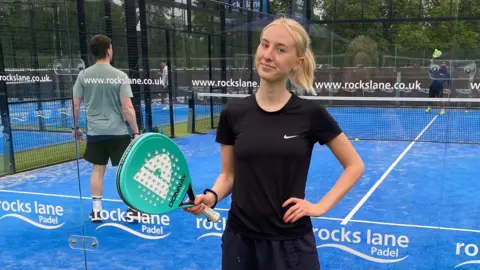Padel has become one of the fastest-growing sports globally, celebrated for its accessibility and social appeal. This unique racquet sport, which combines elements of tennis and squash, is usually played in doubles on a smaller, enclosed court, allowing players to use the walls to bounce the ball back into play. Despite its rising popularity, many potential enthusiasts face a significant barrier: the high costs associated with playing. Rosie Hepworth, a trainee accountant and ardent padel fan, exemplifies this struggle.
Rosie first encountered padel approximately a year ago through social media, immediately captivated by its potential for enjoyment and social interaction. However, she quickly realized that the financial responsibilities tied to the sport were substantial. “I can’t afford to play regularly,” she explains to BBC Newsbeat, noting that her budget allows for only limited play, with an average expenditure of just £30 per month. Occasionally, expenses have surged up to £70, prompting her to consider a month off if faced with other financial commitments, ultimately stalling her progress in the sport.
Finding affordable venues has proved a challenge for many players like Rosie. Even in Central London, where demand for courts is incredibly high, booking a court in advance becomes a requirement, often necessitating a week’s notice. With a mere 800 padel courts available in the UK while over 400,000 players compete for access, many individuals turn to less conventional solutions. To cope with the scarcity, Rosie cycles nearly 50 minutes from her home to facilities offering significantly lower rates and less crowding during peak hours—reflecting a trend among players trying to navigate the financial hurdles of the sport.
Similar circumstances resonate with Barnaby Stephenson, a master’s student at the University of Edinburgh who has been playing padel for two years. Barnaby describes the situation in Edinburgh, where court availability is limited compared to other cities, meaning he often undertakes a two-hour round trip to practice. His university club used to provide free equipment and charge only £2 per session, but they had to end social memberships because of the high demand. Barnaby advocates for greater investment in grassroots initiatives in state schools and public parks to make padel more accessible and lessen the perceived elitism surrounding the sport.
The question of court availability is critical. A recent survey conducted by the BBC revealed that out of the 330 local councils surveyed in the UK, only three reported investments in padel facilities. The Lawn Tennis Association (LTA), responsible for promoting padel in the country, has allocated over £6 million toward this effort, which still accounts for merely 10% of all padel courts located nationwide. Most facilities, consequently, remain privately owned, driving costs higher and enhancing the prevalence of exclusive clubs in affluent areas.
As the LTA prepares to launch a new five-year strategy to address these challenges, there is hope for sustainable growth in padel’s accessibility. Tom Murray, the head of padel at the LTA, noted that the UK is one of the last European nations to embrace the surge in padel popularity. He cites Spain as a successful example of transforming padel from an elitist sport into one that enjoys mass participation, recently hosting the Euro Padel Cup in Madrid, drawing players from 40 nations.
Participation levels reveal gender disparities, with female players making up fewer participants in the UK. Athletes like British number two Catherine Rose and Nikhil Mohindra are eager to amplify visibility and inclusivity within the sport. They argue for a focus not only on female participation but also on promoting diversity across different backgrounds in communities nationwide.
Tanaya Lai, who began her sporting journey in tennis, shared her experiences of being surrounded by predominantly white players, particularly in her current university team. Despite the demographics, Tanaya expressed her hope that Asian women would feel empowered to join without feeling excluded, yet recognized the need for more affordable public courts to remove the barriers associated with financial constraints.
Through interviews with a variety of players, from aspiring competitors to dedicated fans, the discussion of padel’s accessibility in the UK underscores a common narrative: while excitement for the sport is palpable, financial constraints threaten to dampen the burgeoning community. Whether by cycling for cheaper courts, advocating for grassroots investments, or pushing for diversification in participation, the voices of those passionate about padel reflect the hopeful desire for a future where sportsmanship can thrive, unimpeded by cost.



